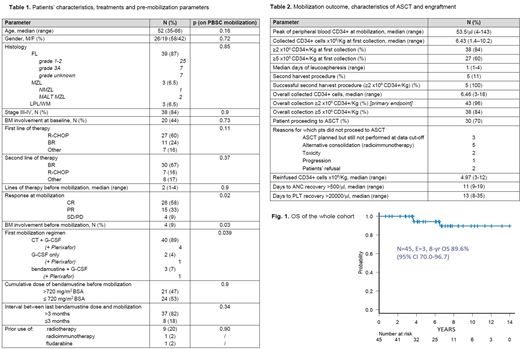Abstract
Bendamustine (B) is an alkylating agent with unique chemical structure (purine-like benzimidazole ring) and high cytotoxic activity. In the last decade, the association of B and rituximab (BR) emerged as the worldwide most popular standard treatment of patients (pts) with indolent non-Hodgkin lymphomas (iNHL), in both relapsed/refractory (R/R) and untreated setting. Autologous stem-cell transplant (ASCT) is the standard option in young fit pts with R/R iNHL and has been recently demonstrated to improve survival of follicular lymphoma (FL) pts with early treatment failure (ETF: within 2 years [yrs] of frontline immunochemotherapy [I-CT], Casulo et al, BBMT 2018). The structure similarity with fludarabine, which is associated with a well-known peripheral blood stem cell (PBSC) mobilization impairment, may limit the use of B in younger pts with iNHL potentially candidates for ASCT. Moreover, the effectiveness of CD34+ cells collection in pts treated previously with B is essentially still unknown and based on few small series.
We retrospectively analyzed rates of CD34+ cells collection in consecutive pts with iNHL undergoing PBSC mobilization attempt, who had previously received treatment with B (in the same or in a previous line of therapy) in 12 centers of the Fondazione Italiana Linfomi. The primary endpoint was the rate of pts who were able to obtain a successful harvest of PBSC (≥2 x106/Kg of body weight).
Overall, we collected complete data about 45 pts with iNHL undergoing PBSC mobilization attempt after previous treatment with B (Table 1). The majority of pts had FL (n=39). Median age at diagnosis was 52 yrs (35-66). Frontline treatments comprised R-CHOP in 27 pts (60%) and BR in 11 (24%). All but 2 pts, who were mobilized during 1st line therapy, experienced disease relapse and initiated 2nd line treatment, including reinduction I-CT, PBSC mobilization and ASCT consolidation. Among pts with FL, 13 (33%) relapsed within 24 months (ETF). Median lines of therapy at PBSC mobilization were 2 (1-4). Eleven pts (24%) received B in 1st line, 29 (65%) as part of 2nd line (n=29, 65%), and 5 (11%) in 3rd or 4th line of therapy. The most frequent mobilization strategy (40 cases, 88%) was CT plus G-CSF (including R-HD-AraC in 27), with "on demand" plerixafor adjunction in 4 cases (10%). Then, two pts (4%) underwent PBSC mobilization with G-CSF only (+ plerixafor in 1) while 3 pts (7%) received G-CSF (+ plerixafor in 1) immediately after a BR course. At first mobilization attempt, 38 out of 45 pts (84%) collected ≥2 x106 CD34+/Kg (Table 2), including 2/2 (100%) in G-CSF only, 35/40 (88%) in CT + G-CSF and 1/3 (33%) in BR cohort (p=0.039), with a median of 1 (1-4) apheresis procedure. Five out of 7 pts who failed first mobilization underwent a second attempt (1 with G-CSF + plerixafor, 3 with CT + G-CSF and 1 with CT + G-CSF + plerixafor) collecting all ≥2 x106 CD34+/Kg. Considering all mobilization attempts, 43/45 pts (96%) reached successful harvest of PBSC (≥2 x106/Kg) and 38/45 (84%) obtained an optimal PBSC collection (≥5 x106/Kg). Median number of PBSC collected was 6.46 x106/kg (3-18). Pre-mobilization bone marrow involvement significantly affected PBSC mobilization (p=0.03), as well as response at mobilization (CR 92%, PR 60%, SD 50%, p=0.02) while cumulative dose of B (>720 mg/m2, p=0.9) or timing from last B administration (≤3 months, p=0.34) did not. At multivariable analysis, mobilization type (p<001) and response at mobilization (p=0.02) retained independent significance, while BM involvement did not (p=0.07). Overall, 30 out of 43 pts who efficiently mobilized PBSC (70%) finally underwent ASCT, with complete and fast engraftment (median time to ANC>500/μl and PLT >20000/μl: 11 and 13 days). We observed 1 case of MDS (EB-2) and 1 sarcoma after ASCT. At a median follow-up of 6.3 yrs (0.7-14), only 3 pts died (2 for progression and 1 for viral encephalitis), with 8-yrs OS of 89.6% (Fig. 1) and a median PFS from ASCT of 8.1 yrs. Notably, FL pts experiencing ETF did not exhibit worse OS (85.7 vs 87.1% at 8-yrs, p=0.7).
High rate of success in PBSC collection reported in this large real-world study supports the evidence that pre-treatment with B does not affect PBSC mobilization in iNHL pts, although we confirmed that B does not display per se a mobilizing capacity. Salvage strategy including ASCT resulted in overall favorable outcome in young pts with R/R iNHL and seemed able to overcome the negative prognostic impact of ETF in FL.
Luminari:Celgene: Consultancy; Roche: Consultancy; Gilead: Consultancy; Servier: Consultancy; Sandoz: Consultancy. Passamonti:Celgene: Consultancy, Speakers Bureau; Roche: Consultancy; Novartis: Consultancy, Honoraria, Speakers Bureau; Janssen: Consultancy, Speakers Bureau.
Author notes
Asterisk with author names denotes non-ASH members.


This feature is available to Subscribers Only
Sign In or Create an Account Close Modal